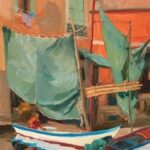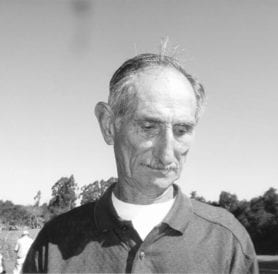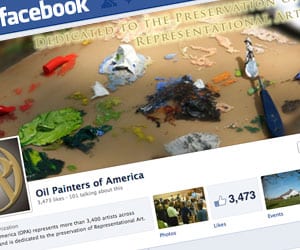
Artists there make more money than doctors, lawyers or university professors. Why? Because they are not, like the others, state employees, and are able to keep more of what they make. Again, why? Because Castro considers them cultural ambassadors and curators, and very important to keeping the Cubans….Cuban.
Would it be worth it to live in Cuba, with the restrictions that entails, to be at the top of the food chain for a change? Not for me. But I can tell you that in many ways the young, hip, vibrant artists that I recently met on my trip to Havana were no different from artists here in the U.S. They were enthusiastic about their current work at the Biennial, complained about the price of art supplies which had to be imported from Europe and knew how to party. The Art gene is a powerful one.
I’ve just started paintings from that wonderful trip. The Cubanos are a beautiful, friendly group. The city of Havana reminds me of a stunning woman “of a certain age” whose beauty is still there under the surface of time’s wear, and I don’t know what they do to the black beans and rice (known as “Moors and Christians”) but my mouth waters just thinking about them. The Buena Vista Social Club music is in the air and makes you want to get up and dance in between endless rounds of mojitos and pina coladas.

Traveling Tips for Oil Painters
I wasn’t able to paint on this trip, but I’m often asked about the nuts and bolts of managing it all. Travel with art supplies takes some careful preparation. Finding art stores can be challenging, if not impossible, in some countries. Besides that, we all have our favorite colors and canvas surfaces and painting in a foreign country can be intimidating enough without trying to make do with unfamiliar supplies.
Since 9/11 the rules regarding combustibles are strict. I often avoid the problem by taking watercolors, but even then those little tubes often look suspicious to a TSA agent. I’ve had no trouble (so far) packing oil paints in my luggage and I thought I’d share what I do, with the understanding that we can but try…
- Before you leave, try to determine how many canvases you’ll be able to complete each day: one in the morning, one in the afternoon, one for good luck? How much paint will you need? If you don’t know how much paint you use in a week or two, start keeping track of what you use before you leave. You’ll probably need a lot of white paint and small (37ml) tubes of colors you use regularly, but just half a tube of specialty colors, like reds for flowers. Paint tubes are heavy, so find out the weight limit for your airline and pack carefully to avoid extra baggage charges.
- I make sure that I include a very visible note (see below) to the TSA on the outside of a double zip lock bag of paints. The note assures the TSA people that the contents are not combustible. I learned on the Gamsol site and others NEVER to refer to the contents as “paint”! The double bag is because the paints might pop open due to baggage hold pressure and you probably don’t want to wear dioxizine purple all over your clothes…for a week.
ATTN: TSA
THESE ARTIST COLORS ARE MADE FROM VEGETABLE OIL AND
CONTAIN NO SOLVENT.
ARTIST GRADE COLORS ARE VEGETABLE BASED WITH A FLASH POINT ABOVE 550.
THEY ARE NOT HAZARDOUS. - The next question is how to transport those precious wet canvases home. Once you know how many canvases you think you’ll need, there are several ways to carry and pack them efficiently. On my first trip to France I precut my 8 x 10” canvas with a 1/2 inch border around them. I carried three or four 1/8 inch gator boards that were another half inch larger than the canvas. (Wildlife painter Carl Rungius just thumbtacked the corners, so you can try that.) At the end of a painting session I pulled the wet canvas off the board, set it aside to dry, and taped a fresh one on for the next day. You can bring dozens of canvases this way with a minimum of weight and space. By the end of the trip–a week or two–the first canvases are pretty dry and can safely be stacked with sheets of waxed paper between them. The wet ones can be mounted on both sides of the boards and taped together with push pin “spacers”, then wrapped tightly in plastic for the trip home. You can also use a light weight card board wet box to transport them home. On my last trip to Italy, I brought Raymar’s Featherweight boards and loved them. Whatever method you decide to use, it helps to bring just one size board so they’ll stack and pack easily. You can always adjust the size with tape if you decide you need a different shape for a particular subject.
- Be sure to carry on the things you can’t live without. I carry a 2 to 3 oz. plastic bottle of Liquin in my carry on “liquids” bag and add a little of it each day to my white paint. That ensures that most of the colors will have some drying agent in them to help speed up the process. I carry on my brushes. We all have our favorites and are unlikely to find them in little out of the way towns). I also include a few canvases, boards and masking tape. These are the things that are hard to replace if my bag gets lost for a few days.
- Needless to say, you cannot pack or carry on Gamsol or turps–the first adventure in each town is finding some at a hardware store or art store if they have one! It helps if you can look up the words for “turpentine”, “mineral spirits”, “solvent” and “odorless” and write them down before you leave the country.
- I also make sure that my brush washer container is as odor free as I can make it–I wash it out in soapy water and double zip lock bag it to avoid having any problem there. I pack my palette knife in my luggage, too, and pray for it’s safe arrival.
- Finally, my “insurance kit”: I always carry on a very compact kit of watercolor paper, paints squeezed out in palette cups and left out to dry before I pack them, brushes and old film containers for water–if the oils don’t make it for a while, I still can hit the ground running and start painting when I arrive in town.


There are no guarantees and the rules change, so be sure to check airline websites before you leave, but these ideas have worked for me and I’ve had so many wonderful experiences painting abroad! I hope you’ll share any travel tips you’ve discovered in your travels with us on this blog. Happy painting–wherever you may be!
“A journey is a person in itself; no two are alike. and all plans, safeguards, policies and coercion are fruitless, we find after years of struggle that we do not take a trip; a trip takes us.”
-John Steinbeck
 Every portrait painting is the result of a series of steps. Some artists have fewer steps than others, and most artists are eager to grab their paints and dive right into the color process. But those who simply pose their model and start painting are taking a lot of chances, such as improperly placing the model on the canvas or discovering a more interesting pose once you’ve already begun. After many hours of your hard work and your model’s patient posing, you don’t want to wipe it all off and start over again.
Every portrait painting is the result of a series of steps. Some artists have fewer steps than others, and most artists are eager to grab their paints and dive right into the color process. But those who simply pose their model and start painting are taking a lot of chances, such as improperly placing the model on the canvas or discovering a more interesting pose once you’ve already begun. After many hours of your hard work and your model’s patient posing, you don’t want to wipe it all off and start over again. This kind of familiarity also pays off because with a live model, no matter how good a model he or she is, your subject is frequently changing. There are many muscles in the human head, more than in any other part of the body, and nearly all of them move when the expression changes on the subject’s face. If you can learn some thing about what muscles made the expression you want, then you can compensate for subtle changes (A smile, for instance, consists of much more than just upturned corners of the mouth.)
This kind of familiarity also pays off because with a live model, no matter how good a model he or she is, your subject is frequently changing. There are many muscles in the human head, more than in any other part of the body, and nearly all of them move when the expression changes on the subject’s face. If you can learn some thing about what muscles made the expression you want, then you can compensate for subtle changes (A smile, for instance, consists of much more than just upturned corners of the mouth.) Portrait Pointer: when you can’t find a model who is willing to sit for several hours, go for photography. Be ready with your camera when a great face comes your way. Just remember, don’t just copy the photo, study the bone structure and value patterns the same as you would when using a live model. Measuring is very necessary. Remember, every skull is different. Don’t generalize. Drawing is not only necessary to portraiture but a beautiful and fun form of art.
Portrait Pointer: when you can’t find a model who is willing to sit for several hours, go for photography. Be ready with your camera when a great face comes your way. Just remember, don’t just copy the photo, study the bone structure and value patterns the same as you would when using a live model. Measuring is very necessary. Remember, every skull is different. Don’t generalize. Drawing is not only necessary to portraiture but a beautiful and fun form of art.






 Facebook could be as important to artists as their favorite supplies. I sensed this when the general manager of a prestigious Scottsdale gallery told me that when all else failed, Facebook helped him locate an artist he wanted to invite into the gallery to exhibit. He believed if an artist had a web address, they would also have a Facebook page as part of their marketing plan. This seems an incredible story unique to our times and I frequently relay it to artists who profess they don’t have time for Facebook.
Facebook could be as important to artists as their favorite supplies. I sensed this when the general manager of a prestigious Scottsdale gallery told me that when all else failed, Facebook helped him locate an artist he wanted to invite into the gallery to exhibit. He believed if an artist had a web address, they would also have a Facebook page as part of their marketing plan. This seems an incredible story unique to our times and I frequently relay it to artists who profess they don’t have time for Facebook.
 There is no law that requires you to have a website, no one is forcing you to use a cell phone and no one mandates that you drive a car.
There is no law that requires you to have a website, no one is forcing you to use a cell phone and no one mandates that you drive a car.